If you’ve been around our gardening blog, you’ll know we are big fans of growing food in containers.
We grow almost entirely off-grid, too, relying on rain water catchment as our primary source of water.
In cold climates, like the subarctic where we are growing, container gardening is an awesome technique for creating warmer soils, which results in objectively better food production.
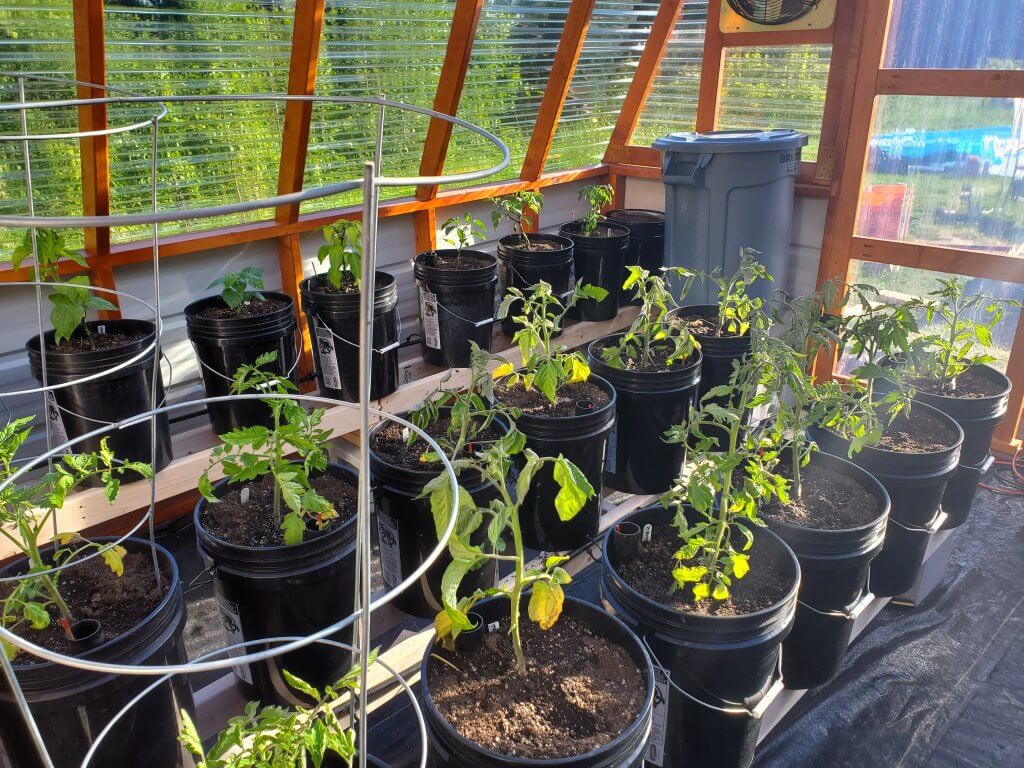
This photo shows our completed greenhouse GroBucket system, fully centrally irrigated via an off-grid reservoir.
We have extensively discussed our use of GroBuckets from a company called GroTech Garden Products. We have built our entire subarctic container garden around this product.
In this post, we’ll discuss how we built our central irrigation systems for our container gardens.
You can also check out our video on our container gardens, which covers everything in this post:
The Only Problem With Using GroBuckets
We have been incredibly thrilled with the performance of the GroBuckets in our subarctic container gardens. They are far and away the best container gardening solution we have used.
GroBuckets can be used for practically any garden plant, from fruit to flower to root. They significantly ease the pressures on watering your garden. They are incredibly effective at water conservation, which is vital when operating an off-grid garden.
The only actual problem we’ve had is dealing with the scale of our container garden.
We are now using quite a few GroBuckets in our container gardens. We started with a “small trial” of 30 of them. Then we added 30 more. Now we have over a hundred of them.
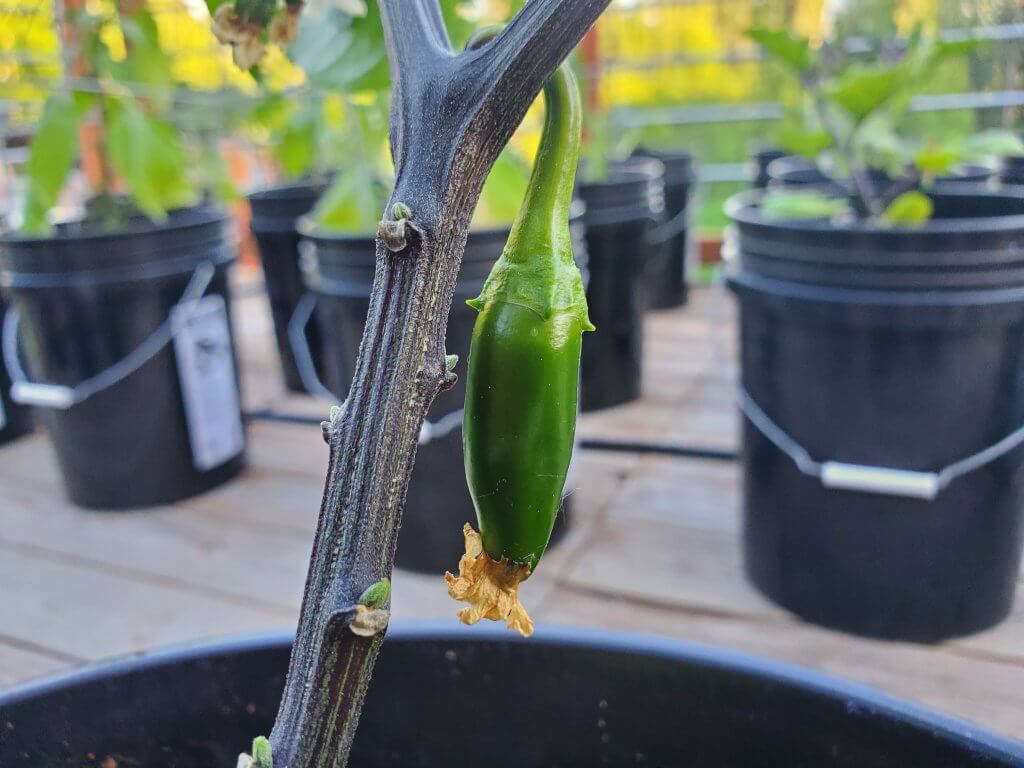
Container gardening is a smart way to grow warm weather crops in the subarctic. We grow all of our warm weather crops, such as peppers, in containers.
At the height of the growing season, it’s not uncommon to see your plants guzzle the entire GroBucket reservoir quickly. Especially on warmer days, sometimes the plants can use the entire reservoir in one day.
Each bucket needs to be filled individually, typically with a hose and sprayer. That’s a lot of bending down and other physical effort to water your container garden.
We wanted to solve this problem, allowing our buckets to be filled from a centralized reservoir. This meant we could also water our container garden in one place, significantly reducing the efforts involved with watering our container garden.
Researching Centralized GroBucket Irrigation Techniques
We didn’t have to venture too far to find a basic source of information for centrally irrigating the GroBucket system.
We found a video from the company that describes the basic technique:
This seemed fairly simple and was almost exactly how we had also envisioned we might also approach the technique.
The GroTech garden company has discussed offering a central irrigation kit. They even sent us one of their prototypes for review.
It’s not like we didn’t like the kit, it would work fine on a certain scale.
The real problem, at least for us, was scaling out this solution to nearly seventy GroBuckets and two different container gardens. We weren’t dealing with a handful of them, like many people probably have.
It is simply difficult to create a universal irrigation approach to these buckets. Different systems might have different requirements. There are as many environments it would need to go into as there are customers.
Thus, in this post we talk a lot about the concepts and principles we are using, so you can turn it into your own system.
Defining Our GroBucket Central Irrigation Strategy
The above video helped us understand what we would need to achieve.
We essentially needed to meet the following requirements:
- All plants needed to be on the same level
- A control bucket would be needed to set the water’s level
- We’d need a mechanism to distribute the water to the individual buckets
- An inexpensive way to interface with the buckets themselves is ideal
We also had a couple of additional requirements, based on our particular situation.
- We wanted the system to be entirely off grid, preferably fed from a large reservoir of water
- Strongly desirable to avoid the use of pumps and use gravity whenever possible
- We wanted to have the ability to “shut off” each GroBucket individually
So, with the scope set, let’s discuss what we actually did to achieve these things!
Considering Other System Design Options
We didn’t go into this project thinking the above manufacturer’s video was the sole way to get this project done.
We considered several alternative designs:
- Installing a float valve in every bucket, which had several complications:
- Expensive
- Couldn’t adjust float valve once soil is added
- Requires expensive fittings
- Uncertainty over whether dozens of float valves could be “operated” by gravity fed reservoirs.
- Winter storage of the buckets would be difficult, unless you removed and reinstalled the float valves every year (a lot of work!)
- Drip system to fill the tubes of the buckets, which also had issues:
-
- Could not make the system account for more or less water requirements in each bucket, likely resulting in large water waste. That may not be a big deal to some people, but for us trying to grow on rain water catchment alone, water conservation is essential.
- True “automation” is difficult to achieve with this design. There are ways to “sort of” do it, but it’s difficult to comprehensively perform.
- In an off-grid scenario, this would require a pump to operate, likely on a timer set for an arbitrary amount of time. Advanced automation techniques (such as soil moisture level detection) would be required to automate this function properly. Plus, if you’re using a reservoir, it presents a risk of running the pump without sufficient water supply.
- This is, overall, a simpler design and an easier solution to implement. It could be done on-grid, or off-grid with pumps. For us, the issue regarding water conservation was a big enough show stopper that we couldn’t move forward with this idea.
-
- Most “traditional” techniques like inverted water bottles, water stones and various other “garden watering voodoo” are likely not to make a meaningful impact or provide a scalable method.
- Just continue to hand water our GroBuckets, as the manufacturer intended
As we considered the major options, it became clear that the design shown in the company’s video was overall the best general decision for our systems.
If water conservation wasn’t our primary goal, we would have likely considered a drip based system. Overall, this would have been much easier to implement, however, the water waste factor cannot just be ignored if that’s in any way important to your design requirements.
How The Control Bucket Works To Control Water Level
Before we get into the control bucket and rest of the design, we’ll briefly explain what we are trying to achieve with our central irrigation system.
We are borrowing a basic physics principle to solve our problem. Water will always seek its own level.
If you have ever seen a “water level,” this is basically the principle we are using for our central irrigation design.
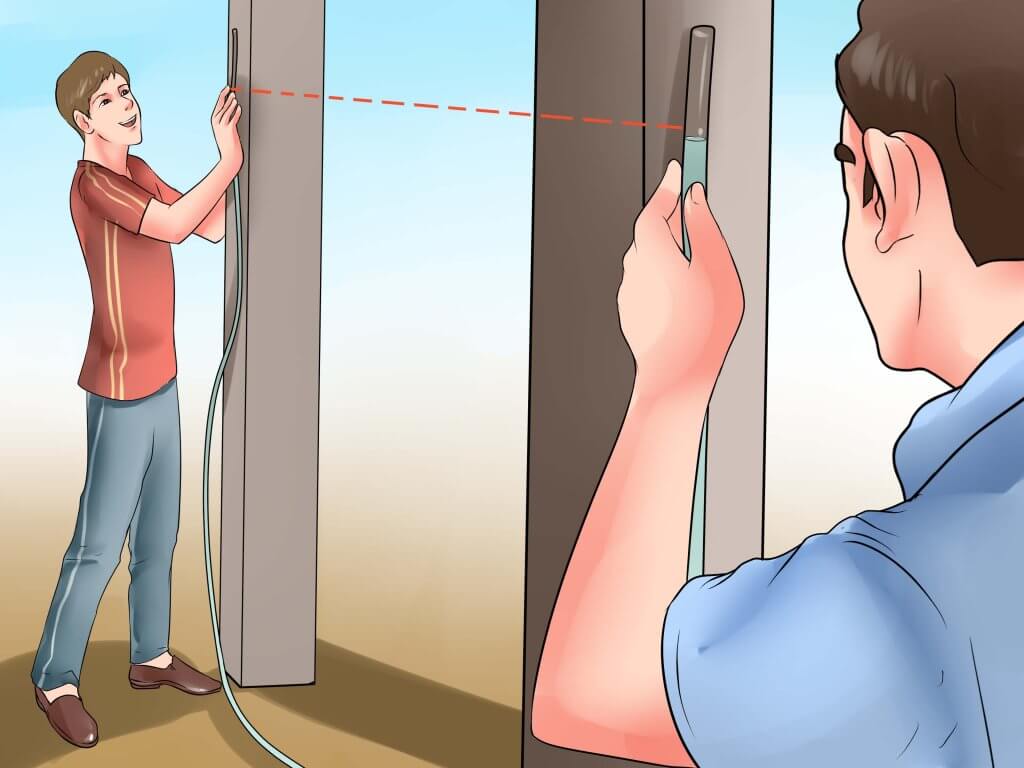
Imagine you have two buckets. If you fill them both with water, they will have as much water in them as you put into them. If one is more full than the other, it will remain that way.
However, if you interconnect those two buckets, say with a hose, the behavior will change. The bucket that is more full will start to fill the less full bucket. The two buckets will “equalize” at exactly the same level of water.
This same principle remains true, no matter how many buckets you interconnect. We are going to exploit that here in a second.
With our irrigation system, we are basically going to use our control bucket to “set” the water level across all of our GroBuckets. This will ensure one bucket is not more full than another.
The control bucket is going to be responsible for controlling the water level in our buckets.
How To Create A Level GroBucket Container Garden
There are a number of ways to go about leveling your container bucket garden.
The simplest way is to have your garden in a place that is all ready fairly level.
We grow some of our food on our fairly large deck. This happens to be fairly level as is, so we didn’t have to do much for this garden.
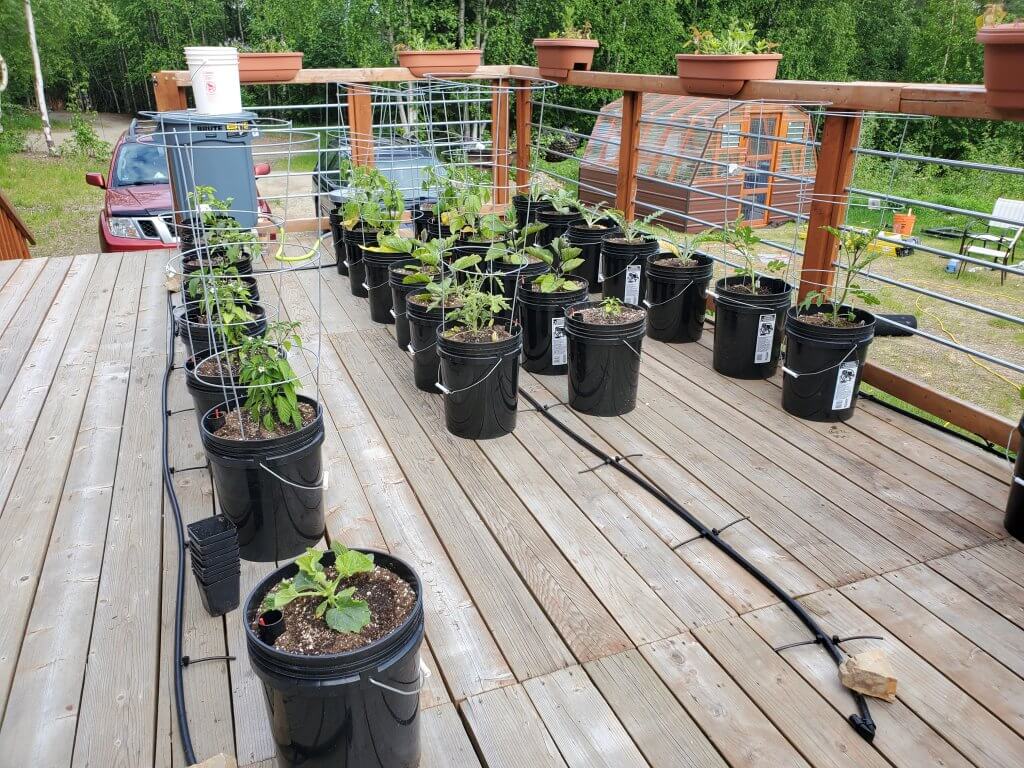
This is a picture of our centrally irrigated GroBucket garden on our front deck. We didn’t have to do much to level it as it was all ready fairly level. We like growing on our deck because it acts as a natural deterrent to moose, which are a serious threat to any subarctic gardens.
For our greenhouse garden, though, we’d need to figure something else out. The ground of our greenhouse features some variation where we can’t just assume everything is level.
We really didn’t think it was best to develop a complex contraption for leveling our buckets. Lumber prices are fairly high and minimizing their use would be ideal. There is no need to “secure” the buckets, so long as you are careful in your grow space.
What we decided to do was create some small frames that could be set between two concrete blocks, like so:
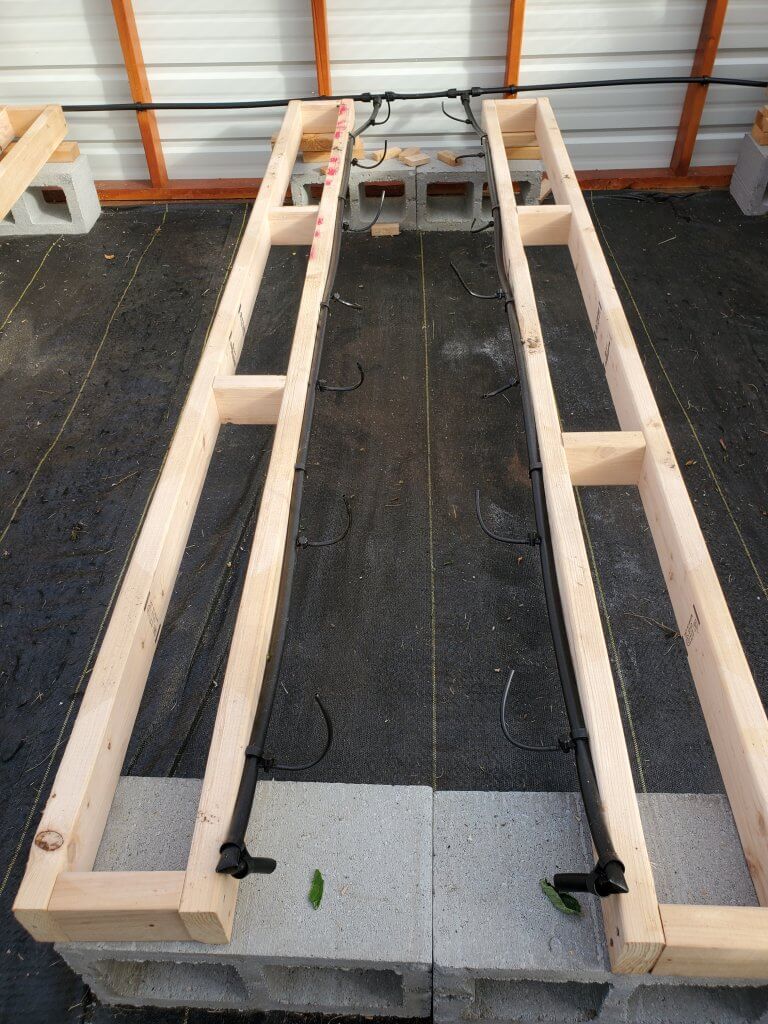
The simplest design we came up with was a frame like structure, built from 2×4’s. The spacers are about 3 inches, which offers about 6 total inches of support for the bucket.
Although we used a pneumatic nailer to assemble these, that is by no means a requirement. We selected a base width of around six inches, which seemed like enough to securely stabilize the buckets. They can be wider, if desired and whatever length you choose.
For longer spans, greater than about six feet, we put in a second support block. The buckets are going to be somewhat heavy, so we can’t expect too much of the lumber frames.
Adjusting The Level Of The GroBucket Garden
With the frames in place, we can then use “spacer blocks” on either side, cut to specific heights, to achieve level. We cut these spacer block from 2×4 material and they work fine.
These “spacer blocks” allow us to raise the height of either end to the desired level.
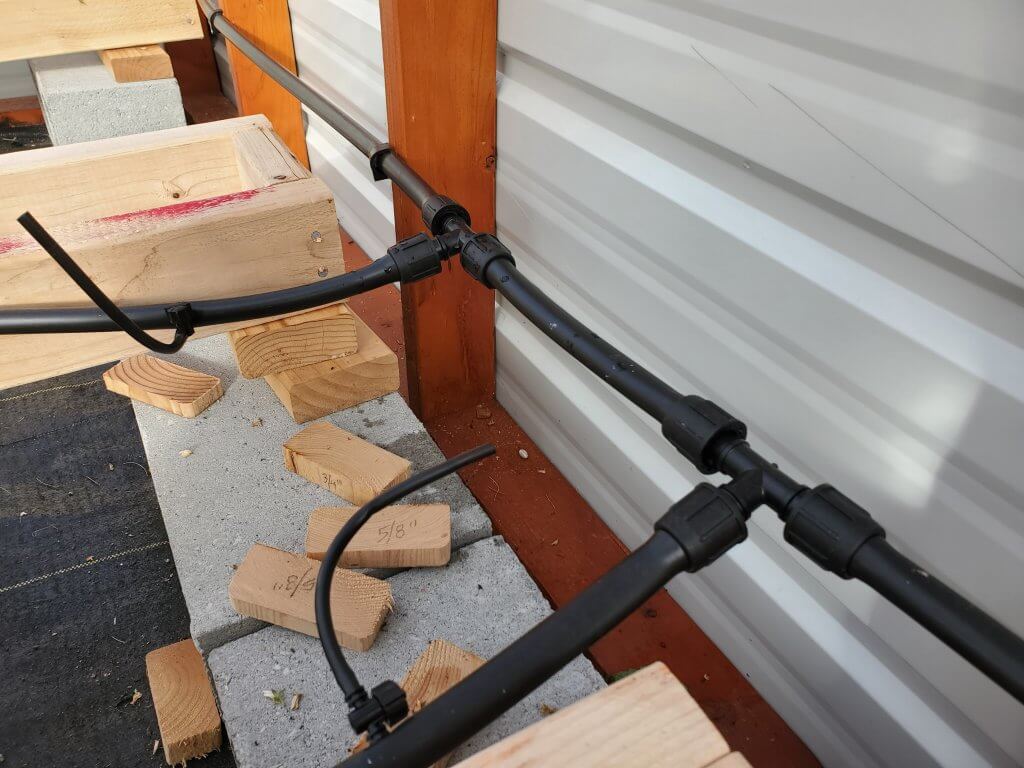
In this picture, you can see some of the spacer blocks we created. Also, how we used cut 2×4’s to raise the individual frames to a desired height.
The construction methods used here don’t have to be bullet proof. We don’t need seismic ratings or to survive hurricane force winds. The point is to level some buckets, not survive a disaster.
We happened to have a laser level that we used to find “perfect level” for all of our frames. We used this to ensure that all of our frames and buckets would be at the same level.
You can also use a regular level, although this is slightly harder. To check various frames for level, you can put a straight 2×4 across them and check your level on that.
You can also not worry about it that much. We are essentially building a giant water level with this system and we can use water level as a level indicator later. More about this later.
Designing The Control Bucket For Central GroBucket Irrigation
With some of the aforementioned knowledge of what we want to achieve, we can design our control bucket.
For the control bucket, we’re going to need an inlet and an outlet. The inlet accepts water from the reservoir or other water source, such as your hose bib on the house. The outlet feeds water to the rest of the bucket system.
In order to control the water level in the bucket, we’ll also need to use a float valve.
Don’t get scared! If you’ve ever used a common toilet, which is almost anyone reading this, you’ve seen a float valve in action. The float valve is what stops the water from overflowing the tank on the back of your toilet.
The actual parts you might need heavily depend on your specific float valve and what you want to adapt it to. In our case, we wanted to supply our float valve with a the male end of a garden hose. We also wanted to output to be ready for the female end of the garden hose thread as well.
We wanted both the inlet and outlet to be based around 3/4 inch garden hose thread. This meant we could connect a garden hose to either side and was just how we wanted to do it. You could use other threads and connectors as well, with appropriate adapters.
These are the parts we used for our control bucket:
- Adjustable Float valve with 1/4″ NPT male inlet
- 1/4″ female NPT to 1/2″ male NPT adapter
- 1/2″ female NPT to 3/4″ female garden hose thread adapter
- Garden hose threaded bulk head for the outlet
In case some of the acronyms above confused you, NPT means “national pipe thread.” It is a technical plumbing standard, most commonly seen in North America. Additional terms are MTP, or male pipe thread, as well as FPT for female pipe thread. They are all the same plumbing standard.
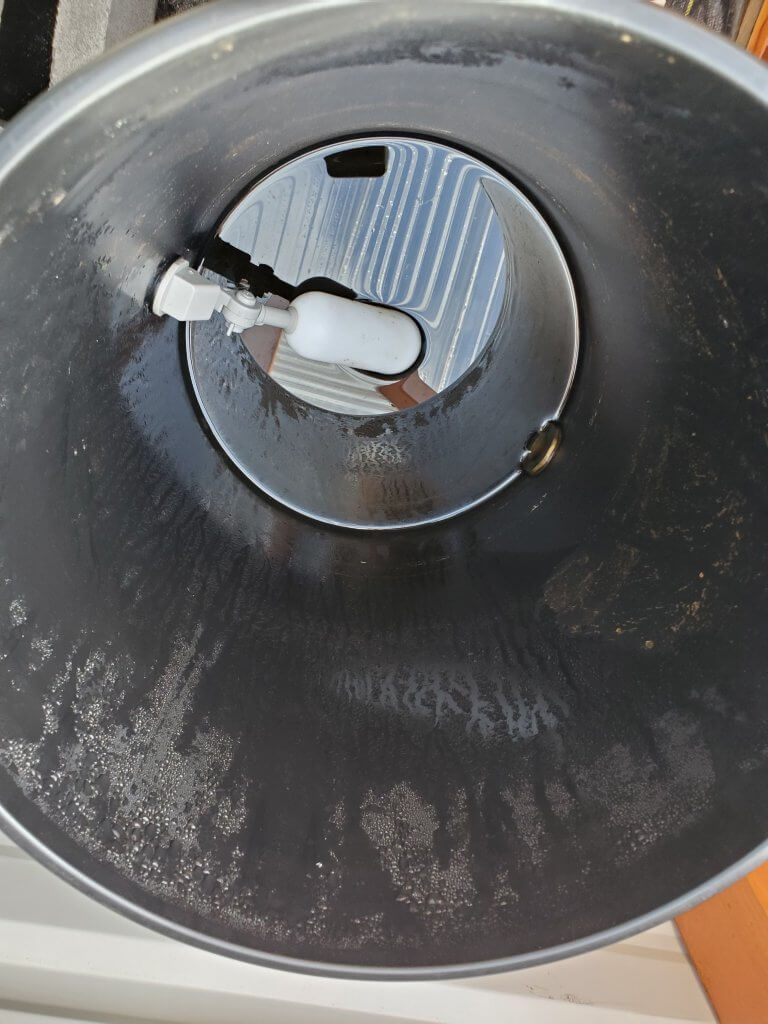
This is the inside view of our control bucket. On the left, we have our input and float valve. On the right, you can see the bulk head. Both the inlet and outlet are 3/4 inch garden hose thread.
The float valve was installed about 3.5″ inches from the bottom of the bucket. This is approximately where the overflow hole will be in the rest of your GroBuckets. We use an adjustable float valve so can control the specific water level.
The outlet bulkhead was installed as low on the bucket as it could get. This isn’t super critical, just make sure you don’t hit the bottom of the bucket when you drill your hole.
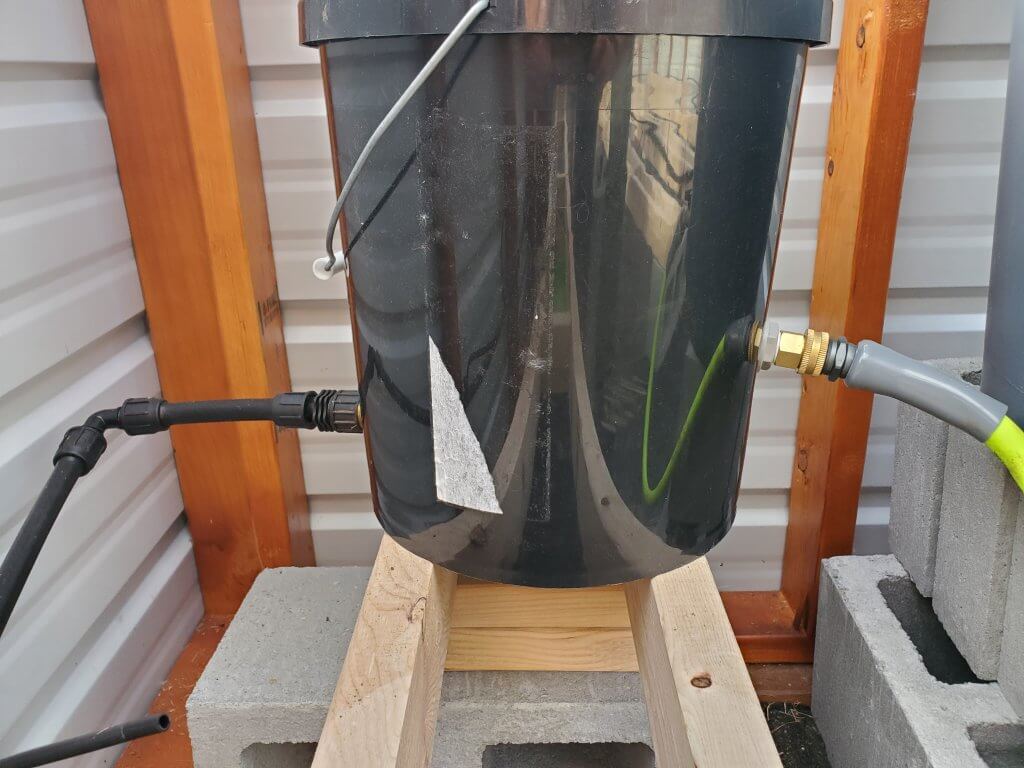
This is the external view of our control bucket. You can see both the inlet (right) and outlet (left) are garden hose thread. We had to use adapters on the inlet to get the desired thread.
To install our fittings, we drilled a pilot hole in the bucket at our center point. We then finished the hole with a step bit to the final size. You could use a hole saw of the correct size, but a step bit will give you a cleaner final result.
As for where you put your holes, you do need to put some thought into how the control bucket will be integrated into your specific system. We chose them to be on opposite sides of the bucket, but you have any degree of flexibility with this you may need.
Building A Manifold To Distribute Water To Your GroBuckets
We need a way to get our water from the outlet of the control bucket to each of our GroBuckets. What we are building here is essentially a manifold.
There is a ton of flexibility in what this actually looks like and it depends entirely on your layout.
We opted to use standard irrigation tubing for our manifold. This is a fairly inexpensive material that has a lot of cheap adapters, parts and pieces that can be used with it.
We like to use a company called Drip Works for our irrigation supply needs. We aren’t sponsored by them or anything, but we like them. Their Easy-Loc series are great, reusable irrigation fittings.
We selected standard 1/2 inch irrigation tubing as the “primary” water distribution material. It was installed all around our greenhouse and also on our deck.
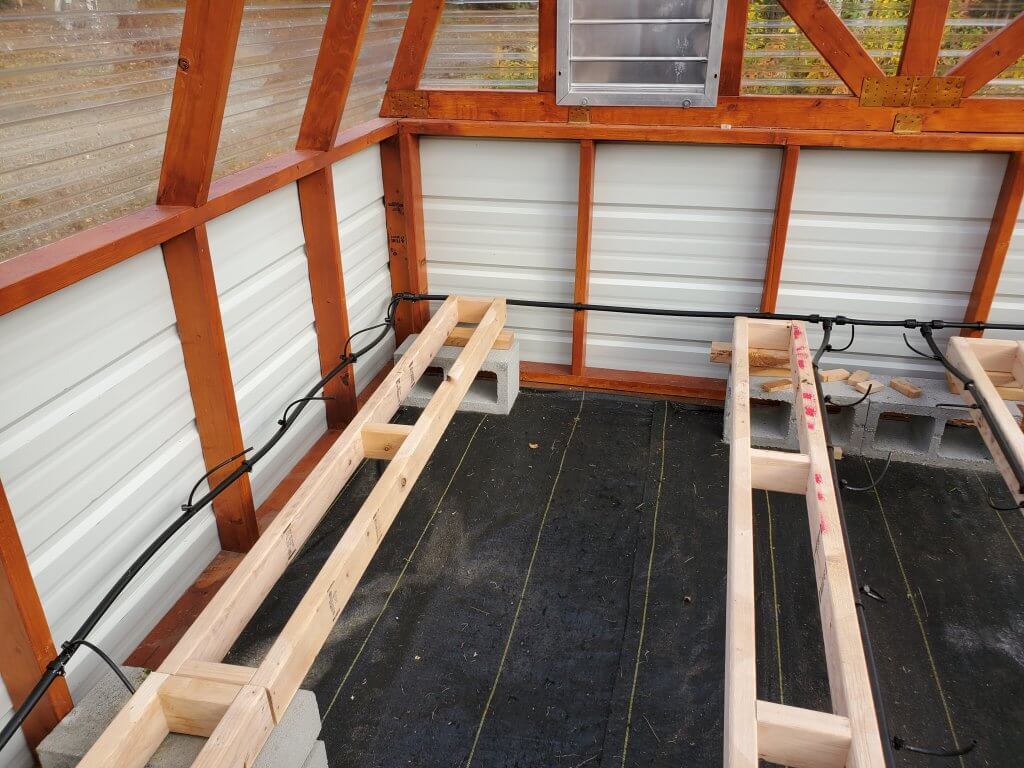
The larger black tubing in this picture is our water distribution manifold. We have this larger hose where all of our buckets will be. It is made from standard irrigation parts.
We used some tubing clamps to secure the 1/2 inch irrigation tubing to our greenhouse walls. On our deck, we didn’t bother securing the tubing and it really isn’t necessary.
Again, this manifold is highly custom and dependent on your specific needs. There are a host of parts you can use to build something like this. Overall, we used the following parts to build our custom manifold:
- 1/2 inch irrigation tubing
- 1/2 inch Easy-Loc right angle fittings
- 1/2 inch Easy-Loc tee fittings
- 1/2 inch Easy-Loc tubing to female hose thread fitting
- 1/2 inch tubing clamps
- 1/2 inch tubing figure 8 (to close the loop)
For the feeds into individual buckets, we stepped down to 1/4 inch irrigation tubing to interface with the individual buckets. More about this later.
This system is not “high flow” and does not need the 1/2 inch irrigation tubing capacity. We simply chose it because it’s a bit easier to work with than 1/4 inch tubing. It especially lends itself well to a more “stiff” manifold.
Interfacing The Irrigation Manifold With The Individual GroBuckets
This is where we really needed to get creative in the project and where it all comes together.
We wanted to find the absolute cheapest way to interface with our individual GroBuckets. We seriously wanted to avoid things like brass fittings and threaded adapters as it would be very expensive.
There is a certain kind of bulkhead adapter called a Uniseal. They are manufactured from a soft rubber type material. It creates a friction fit that is basically water tight, if things are the appropriate size.
The great news about Uniseals is they are relatively inexpensive. They happen to make a 3/16 inch size Uniseal that interfaces perfectly with 1/4 inch irrigation tubing. It just so happens, 1/4 inch tubing is a very common size of irrigation tubing as well.
You do have to make sure your 1/4 inch irrigation tubing is exactly .250 inches in the outer diameter. There are variants that use other standards, like .220 inches, and they will not work. These are often still called 1/4 inch tubing, so be careful.
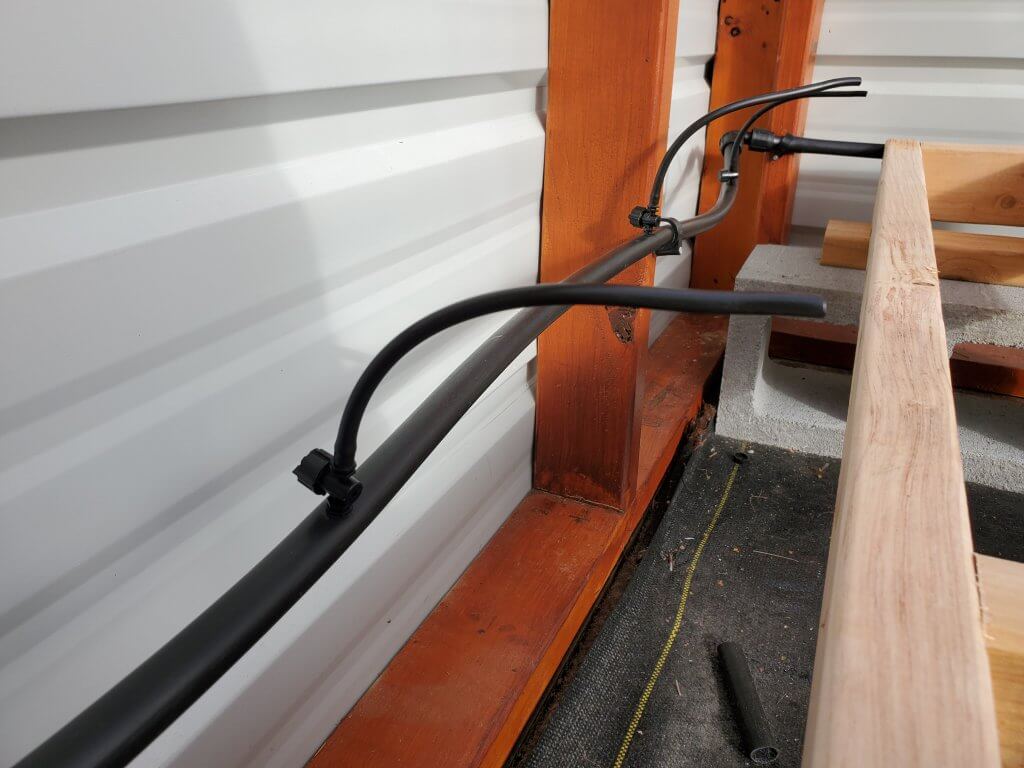
This picture shows the interface that we use for the individual buckets. The 1/4 inch tubing is simply pressed into the Uniseal installed on the bucket, creating a water tight seal.
This allowed us to install a 8mm hole on our bucket and insert the Uniseal. We can then “stub” the 1/4 inch irrigation tubing right into the bucket. It is fully sealed, water tight and has performed without issue for us.
We drilled this 8mm hole as low as possible on the bucket. You want it well below the normal drain hole you would install in your GroBucket. Be careful not to hit the bottom of your bucket.
Here are the parts we used to interface with the buckets
- 1/4 inch barbed transfer valve
- 3/16″ Uniseal
- Length of 1/4 inch irrigation tubing
Since we used irrigation tubing, the entire system is designed around interchanging tubing sizes like this. A transfer barb allows you to go from 1/2 inch tubing to 1/4 inch tubing very easily. You need a tubing punch to install the hole in the 1/2 inch tubing.
As noted in our requirements, we wanted to be able to turn off a bucket, if needed. We might need to remove a plant, do some system maintenance or just no longer want to grow a single bucket.
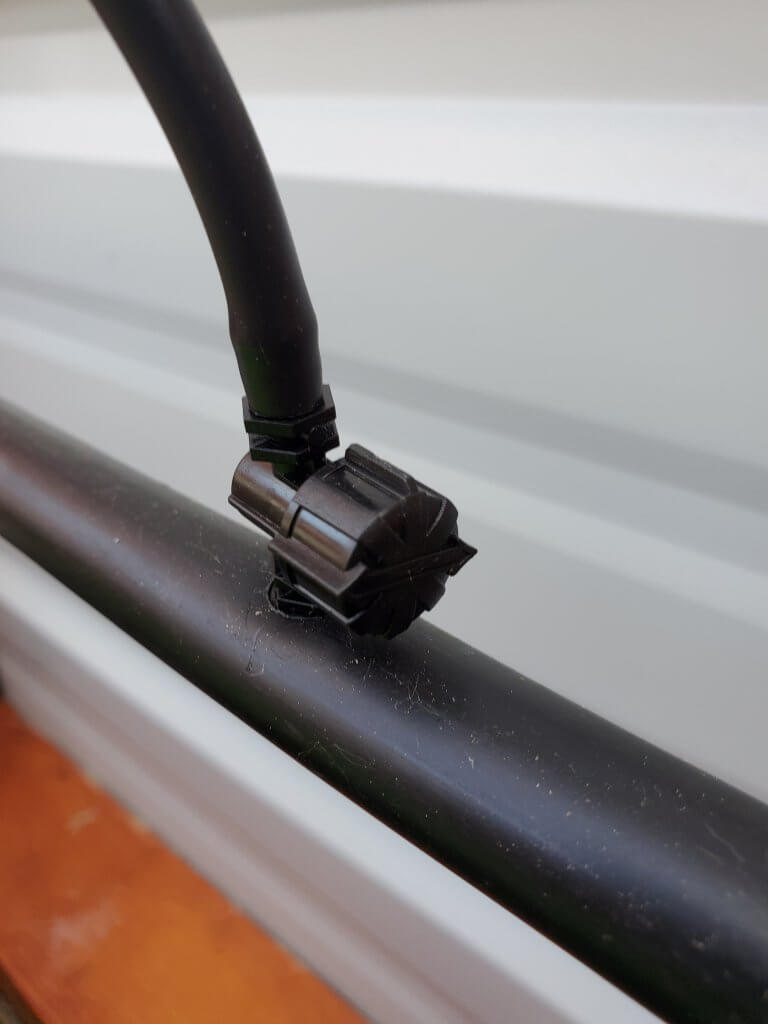
This picture shows the 1/4 inch transfer barb with an integrated valve. This is how we are able to shut off each individual bucket’s feed, if needed.
The valves we used are perfect for this purpose and also were not that expensive. If you don’t need this capability, you can use normal transfer barbs. It is super handy, though, let us tell you!
One of our readers pointed out that we hadn’t mentioned a drain hole in the buckets. Our GroBuckets use the standard drain hole called for by the manufacturer, at 3.5″ from the bottom of the bucket. This ensures additional water, such as from rain, will properly drain away from the system.
Irrigation System Plant Spacing Considerations
As you might have gathered with the aforementioned information, you can place your GroBucket sites anywhere along the manifold, at any desired intervals.
We chose to use 18 inch spacing in between our growing sites. This was largely a reflection of what we needed to grow.
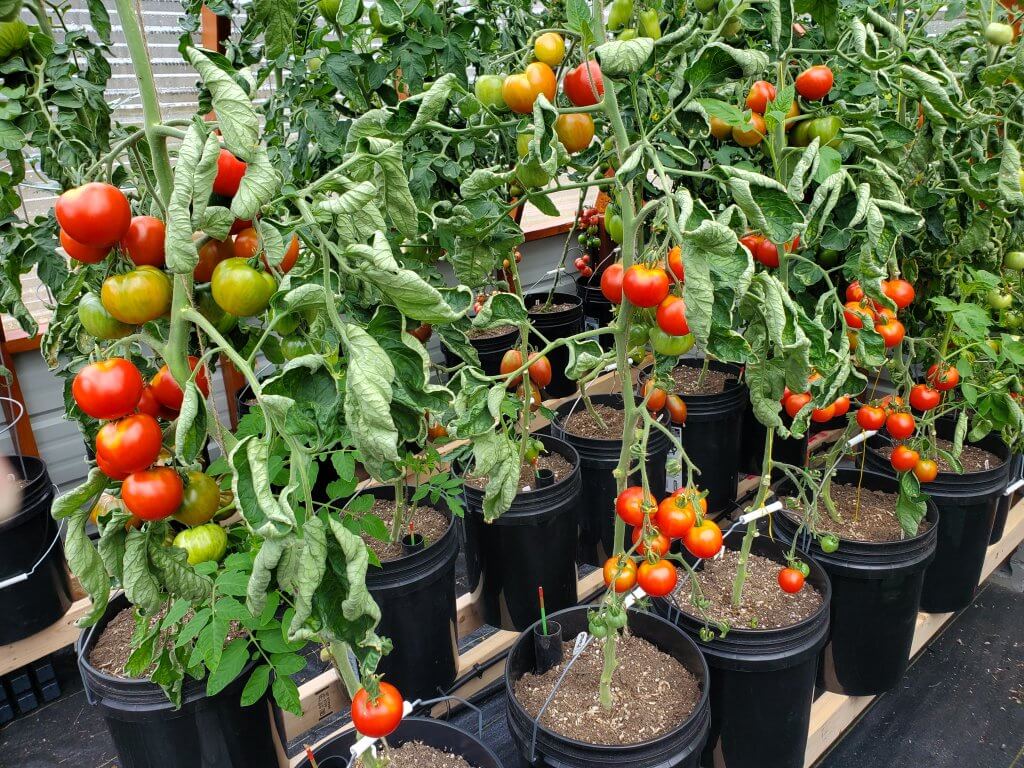
It would likely be beneficial, in some cases, to change that spacing. For example, we currently grow our artichokes in our GroBuckets. They could really use greater than 18 inch spacing. If you wanted to grow cabbage or other really large plants, spacing is going to matter.
One of the reasons we like the Easy-Loc system from Drip Works is because we can re-use the fittings to our desire. It’s easy to substitute a different piece from year to year. It’s not difficult, or expensive, to create a flexible set of irrigation manifold parts that can be changed out from year to year.
This is just one of the reasons why it’s difficult to create “one size fits all” irrigation solutions. They are unique to each garden and even the plants you want to grow.
Making Our Off-Grid Reservoir For Feeding Our GroBucket Systems
Up to this point, you have the option of feeding water into your system from a variety of water sources.
You could simply use a garden hose connected to your home water. This has its benefits, but for us, was not an option. We need to make our irrigation system entirely off grid and based around our rain water catchment systems.
For our system, we decided to go with a fairly traditional reservoir type of set up. We could have chosen a number of vessels, but we decided to go with a standard 32 gallon Rubbermaid garbage can.
These specific garbage cans are known to be food safe and a good choice for reservoir systems.
To make ours, we simply used a standard 1/4 turn spigot, installed at the bottom of the garbage can. This allows us to turn the water supply on and off, when desired.
If we haven’t mentioned it all ready, we always use teflon tape on standard pipe threads. If you aren’t familiar with basic plumbing skills and techniques, this project will certainly teach you them.
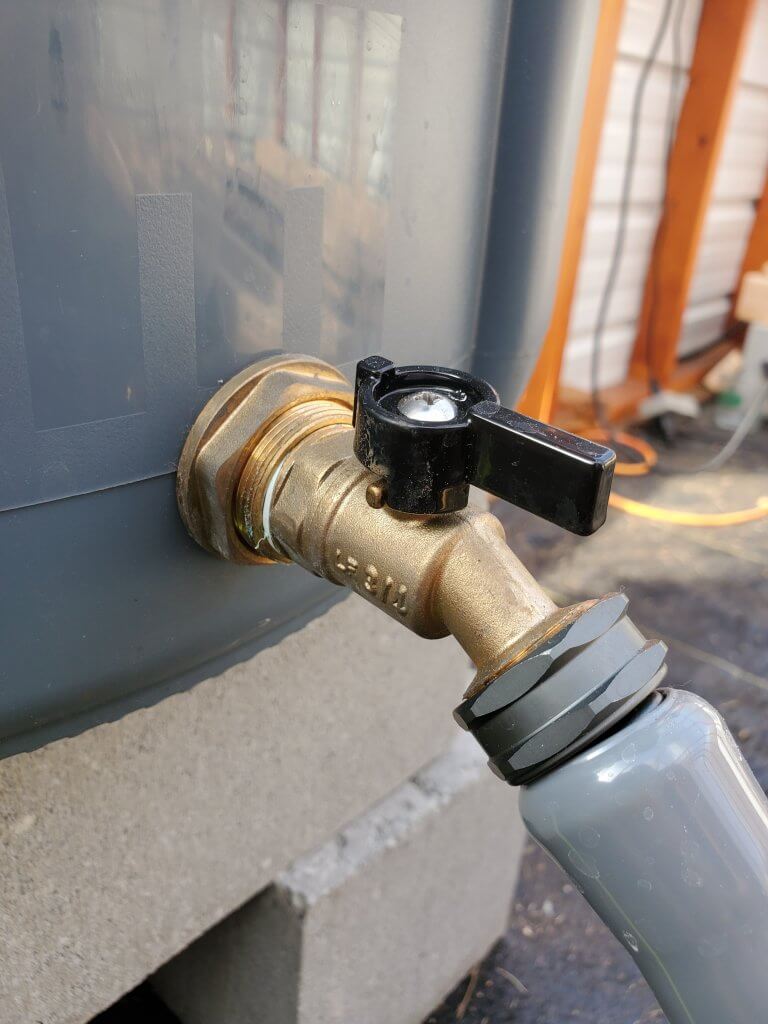
The key to interfacing a reservoir system like with this irrigation system is that the reservoir has to be physically above the input to the control bucket. We raised our reservoir on a few concrete blocks to achieve this.
The primary reason we needed to do this is to allow gravity to fully drain the reservoir into the control bucket. The float valve installed into the control bucket will control whether water is allowed into the system or not.
To interface with the rest of the irrigation system, we used a short three foot hose between the reservoir’s outlet and the control bucket.
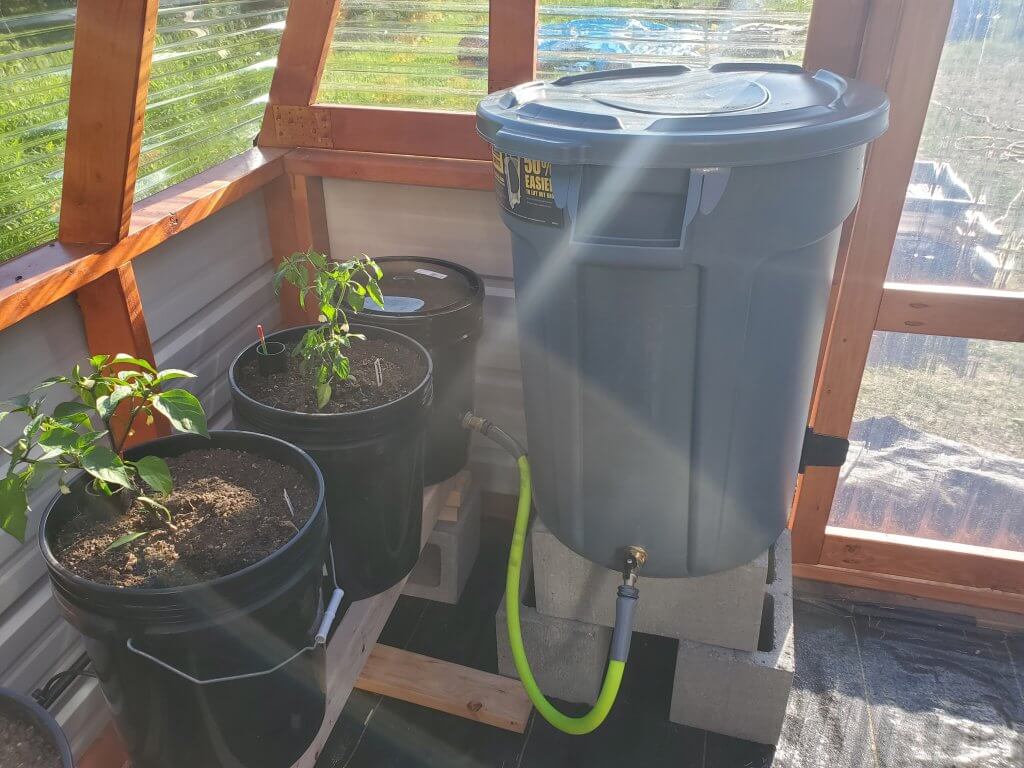
We raised our reservoir so that the outlet from the reservoir would be physically above the input to the control bucket. The reservoir is connected to the control bucket with a short 3 foot hose.
These are the specific parts we used to make our reservoir:
- 32 gallon Rubbermaid garbage can
- 1/4 turn rain barrel spigot
- 3 foot garden hose
This whole process is akin to making a rain water barrel. There are a lot of ways you can go about it. This is just how we decided to make ours.
Tuning The GroBucket Irrigation System For Operation
What we found, once we turned the system on, was a bit surprising.
We either suck at leveling. Or, there’s some things we don’t quite understand about the all the various physics in this system.
We used a super accurate self-leveling laser level to ensure level of our garden, so we’re pretty sure it not the former.
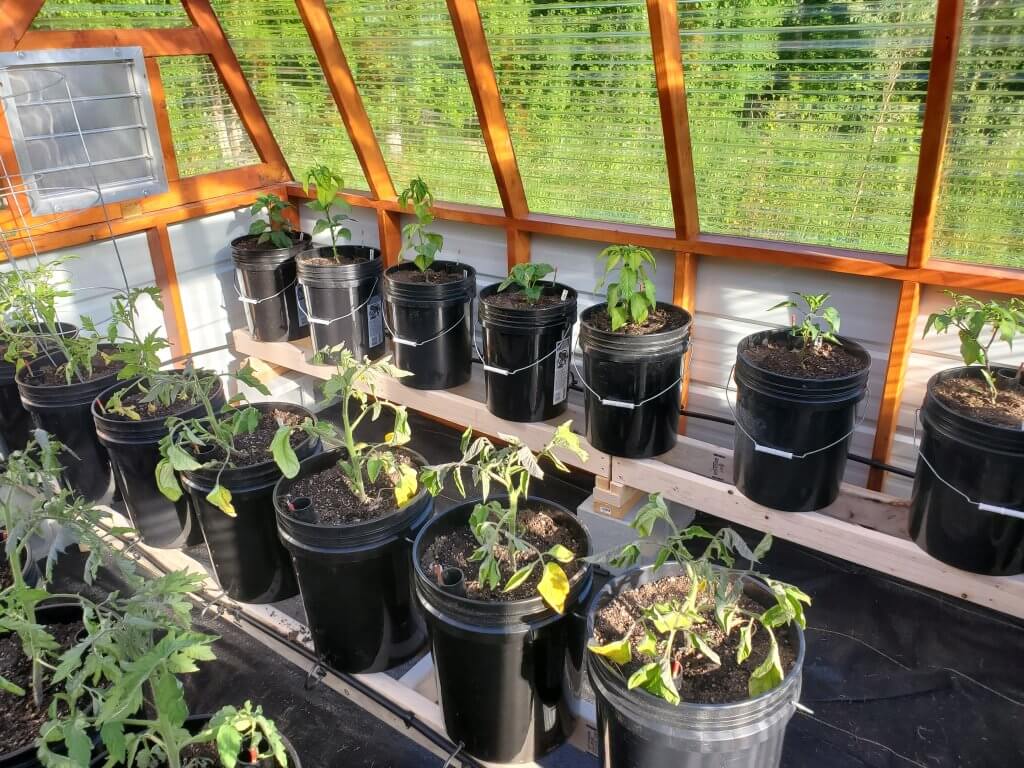
What we discovered was that minor imperfections in the height of our 1/2 inch tubing were enough to create significant air pockets in our irrigation tubing. This prevented water flow throughout the tubing.
We figured out that we can just raise the filled control bucket up (lift it) a few times to “prime” the system. We can hear a gurgling in the system, knowing it’s been effective. Once the system is primed, we really don’t have flow problems the rest of the season. All the buckets DO need to be on the same level, as physics would predict!
Also, if you’re tuning your system, remember that water level changes don’t occur instantaneously. Water moves quite slowly between your individual buckets and it can take a little while for changes to materialize.
It wasn’t quite as turnkey as we had hoped, but it also wasn’t terribly difficult to tweak, either. Just remember, it’s a complex water level.
Off Grid Reservoir & GroBucket Performance
We were probably one of the first people in the world to build one of these centrally irrigated GroBucket systems in an off grid fashion.
There are no references available for how large of a water reservoir is needed for how many buckets.
Our system ended up being about 1 gallon of reservoir volume for each 5 gallon GroBucket. In our greenhouse, we have 31 total GroBuckets. Our outdoor system is configured for 36 GroBuckets. Both are fed from 32 gallon reservoirs.
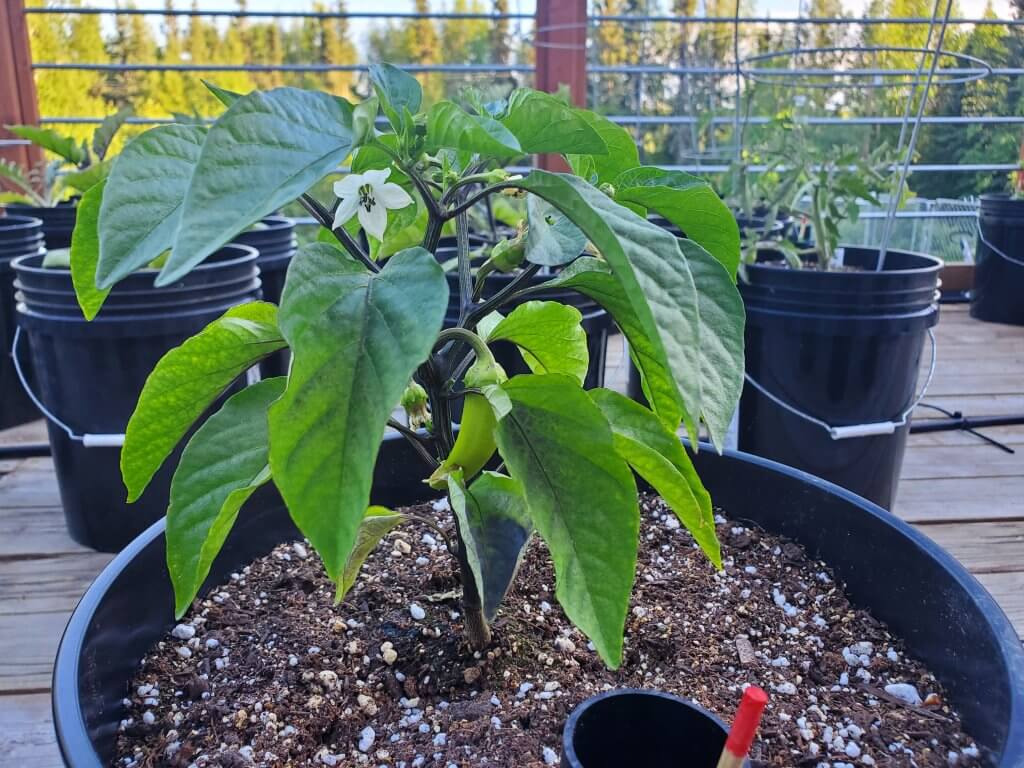
We have been able to go substantial time in between watering. At the peak of summer, we have to fill the reservoir every week or so. In the early season, we were getting weeks in between reservoir fills.
This is huge for us! We can easily go camping or even on vacation without having to arrange for people to come take care of our container garden.
In our design, we originally would have preferred to go with the 45 gallon Rubbermaid garbage can. We ended up having to go with 32 gallon because the larger unit was not available at the time of our purchase.
If we were in a warmer climate, we would likely insist on a larger reservoir. In warmer temperatures, the plants are going to transpire much more and go through the water much faster.
Alternatively, since you’re now familiar with float valves. There is no reason you couldn’t auto top off your reservoir, too.
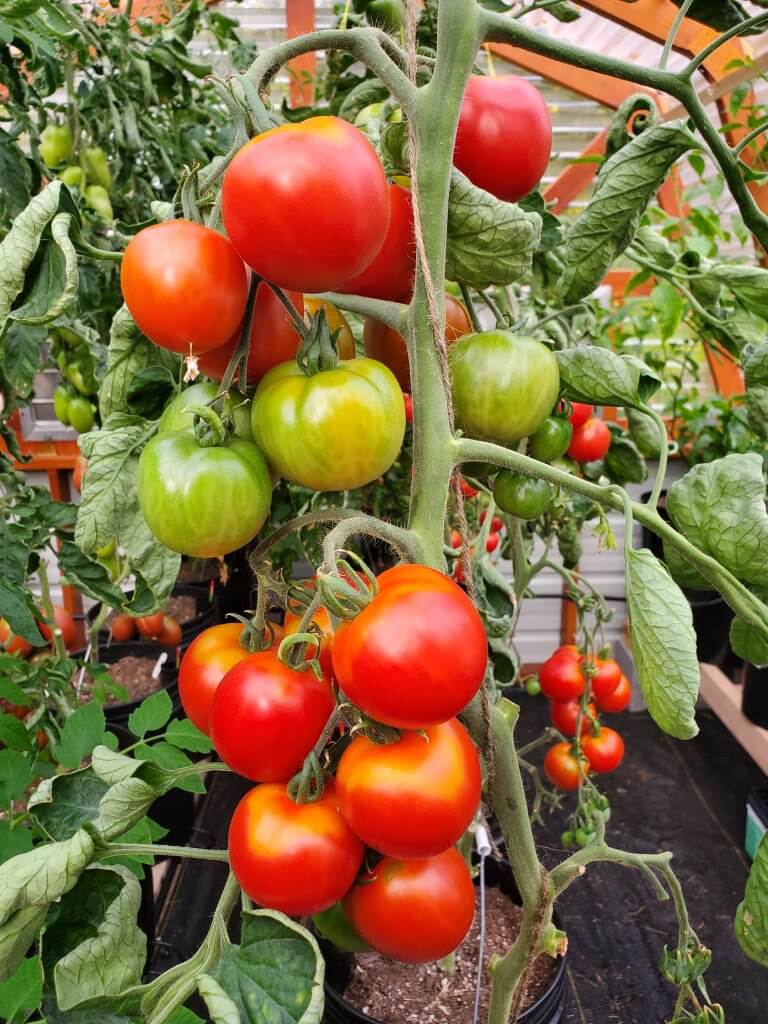
We were able to support dozens of thirsty tomato plants with our GroBucket central irrigation system. We got incredible growth and maturity rates.
In our outdoor system, we notice that we go through considerably less water. Growing outdoors, we do get occasional “help” from rainfall. Also, the cooler outdoor temperatures that we experience simply cause the plants to transpire less.
The system has been really easy to work with in relation to off grid water supply sources. Many times, we used 5 gallon buckets to fill our reservoirs, but we could have just as easily filled them with a hose.
We prefer to use fertigation techniques in our GroBuckets, so measuring the water supply is important to us anyway.
Centrally Irrigated GroBuckets Will Change Your Life Forever
This project has been amazingly transforming for us as gardeners.
By solving the container garden watering problem, we have effectively put our entire container garden on autopilot.
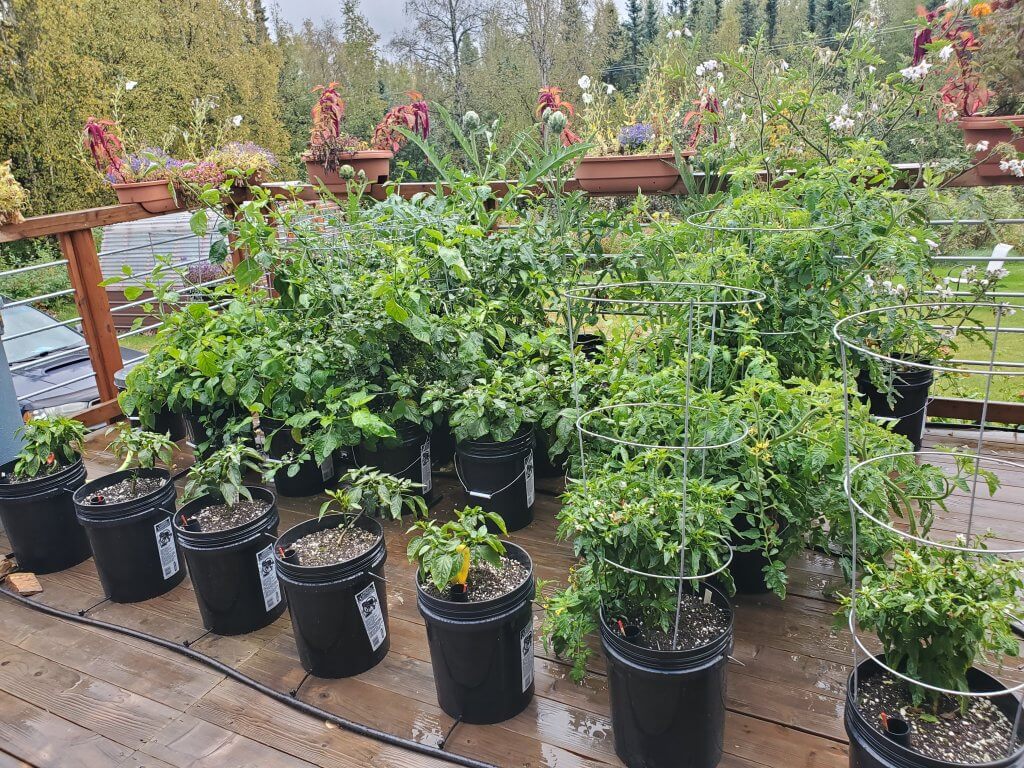
This picture shows our deck GroBucket garden, fully irrigated. As you can see, we can effortlessly support growing a ton of food!
While there were a number of ways we could have gone about centralized irrigation of the GroBuckets, we were quite happy with how things turned out. We love how low tech it is and overall how little can actually go wrong.
Both our greenhouse and outdoor container gardens are basically on very infrequent watering schedules. It’s incredibly easy to determine when the system needs more water.
Our container garden is pretty much planting, harvest and trimming the plants occasionally. We love being able to focus on these things, it’s why we garden to begin with.

Our greenhouse jalapeno peppers produced all season long for us on our centrally irrigated system!
In our GroBucket experiments, we found curcurbits (squash, cucumber, etc) really go through the water when they are allowed to. A system like this could be used to grow these plants on turbo mode, with very little effort.
Scaling The GroBucket Irrigation System
The beauty of this system is, once you understand its principles, can be scaled to practically any level.
It could scale up to a thousand buckets, or down to just a handful.
If you were in a situation where you needed say, multiple levels, that can easily be done. You simply need a control bucket for each individual level. This could allow the system to be integrated into a “terraced” type of system.
Just to play with this idea, we also tried to centrally irrigate our small indoor grow tent using this method.
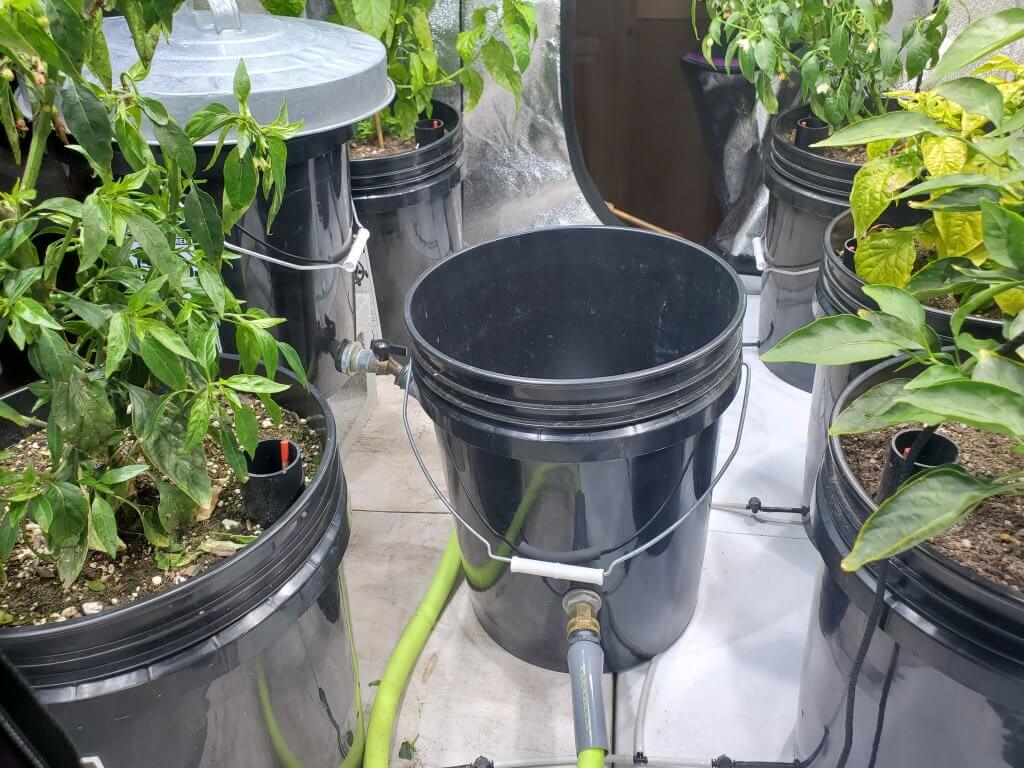
In this particular case, we used a 5 gallon bucket as our reservoir to grow six plants. It worked well enough and would be perfectly suited to indoor food production using the GroBucket system.
In this particular case, we were just messing around. But, you could likely optimize this system into something pretty unique. We would consider using a 3 gallon control bucket and a 7 gallon reservoir. We would also would try installing the reservoir directly on top of the control bucket.
Explaining Difficult Topics Is Hard
If you’ve made it this far, we appreciate your dedication.
If you are interested in building a system like this, we hope that it helps you. The information is also hopefully relevant to many different irrigation techniques.
If you have no idea what this was about, we’d encourage you to explore some of the links in this post. We’ve linked to various information about how we utilize containers as one of our core gardening strategies for cold climates.
As always, if you have any questions or need us to clarify anything, feel free to slap a comment down below. We always appreciate interaction with our site and that’s a big reason why we explore some of these obscure gardening techniques.
That’s All We Wrote!

Having a good time? We have an ever growing list of insightful and helpful subarctic & cold climate gardening articles, waiting out there for you!
- Cold Climate Gardening Basics 👉
- Growing Your Garden From Seed Indoors 👉
- Advanced Cold Climate Gardening Techniques 👉
- Plant Specific Cold Climate Growing Guides 👉
- Subarctic Perennial Food Forests & Foraging 👉
- Indoor Garden Lighting & Grow Rooms 👉
- Greenhouses & Temperature Control 👉
- Harvesting & Food Preservation 👉
- Solving Cold Climate Garden Problems 👉
- 1 Minute Reads On Tons Of Garden Topics 👉
FrostyGarden.com is 100% ad-free and we do not use affiliate links! This resource is voluntarily supported by our readers. (Like YOU!) If we provided you value, would you consider supporting us?

This is an incredibly useful project! Very generous of you to share this with the world. What a brilliant idea to automate the automated self-watering system Would love to build something like this one day after I retire. I live in CA so my pots are on the patio where there’s more sun but need more than once watering by hand so was considering SW system when I ran into this. Just wanted to show my appreciation.
Thanks for your kind comment! This has been a great technique for us. This coming summer will be our third year with it. I can’t imagine going back to hand watering, ever!
This is great! Did you run into any contamination issues sharing water through the hose? I am setting up nearly a hundred of these by next summer and am in the build right now. Thank you for posting.
Hi Bill, thanks! We have not run into any issues with contamination. That could be a risk, especially if you’re growing plants that are prone to root based diseases or if your area or water promotes such things. If this were a major concern, a drip based filling system would be overall much safer. If you were also insistent on saving the waste water from a drip system (like we are, in a low water input garden), it might even be appropriate to develop a return system for the overflow. Although it would be a bit more complicated, such a thing could easily be done with a length of PVC, 1/4″ irrigation hose and some additional Uniseals. Hope that helps, thanks for reading!
Thank you so much for this great detailed post! I’m also cold gardening, in Alberta, and have been looking at ways to make watering my sub-irrigated planters easier, now I have so many. This is incredibly helpful!
Fantastic! It’s a viable method for a lot of different sub-irrigated hardware, easily adapted to different solutions. Good luck with your project!
Definitely gonna give this a serious try all makes sense…great job. I gotta be missing something tho…. I don’t see any mention of an overflow hole. I’m planning on trying this method outside like you have on your deck. What happens when you get a good rain….won’t the buckets fill and possibly waterlog the plant?
Thanks. I really should mention that. All of our buckets do have an overflow hole, as the GroBucket manufacturer specifies. From memory, we have ours at 3.5″ from the bottom, I think? This allows any overflow to be drained and maintains the air gap of the system. In the central irrigation system, we have to ensure the water level is below this point to avoid general overflow. I would say in general, we run our irrigation levels below that hole by quite a bit. (Maybe about 2-2.5 inches of water.)
I am definitely giving this a try! I REALLY appreciate the links to the materials! It is an investment – and one I hope will work for years to come! You talk about how you like the Easy-loc brand because it comes apart more easily. Just how do you take the buckets apart to store them for the winter? Do you label the lines? Do you pull the 1/4 tubing out of the 1/2 inch tubing or leave that alone and pull the 1/4 inch out of the rubber gasket in the bucket? Thanks!
You bet. We really only pull apart the “big” 1/2″ sections to make it more manageable for storage. The Easy-Loc 1/2″ parts are super easy to pull apart and put back together. We do leave the 1/4″ lines and everything else intact with the manifold as that’d be a pain to disassemble and reassemble. We do pull the 1/4″ line out of the bucket, but the uniseal itself stays in the bucket. We can just “stub” it back in the next year. For storage, we just lay the manifold pieces on the ground and let it get covered by snow. Our manifold isn’t super complex, so we can easily identify how it goes back together. But, if it was, we might label it somehow. Hope that helps!
Thanks! That helps a lot! One more question – often when 5 gallon buckets are stacked together they can get so stuck it’s hard to get them apart. Any tips you use for stacking them?
And…can you tell me, or do a post about the growing medium you use in the bucket? Since the water reservoir takes up some room, how much growing medium is in each bucket?
It can be tough to separate buckets that are stacked. We don’t “perfectly” clean our buckets, so usually a bit of rough stuff will help them free themselves. But, otherwise we just work it until they come apart. (Pulling the top bucket with the other buckets trapped by your feet seems to work the best.)
I linked you our soil building page in your other comment, but here’s the link to our soil building page again in case you missed it. We use the Frosty Garden Weapon soil mix detailed in that post. It’s a fantastic soil mix and works great with the GroBuckets. Each bucket uses right about 4 gallons of soil. We fill them to about 1/2 inch of the top of the bucket, tightly packed.